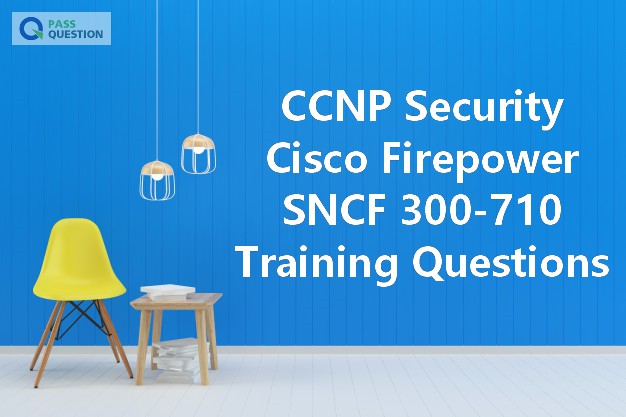CCNP Security Cisco Firepower SNCF 300-710 Training Questions
Looking for Cisco 300-710 SNCF exam preparation? PassQuestion got the latest CCNP Security Cisco Firepower SNCF 300-710 Training Questions to help you pass your Securing Networks with Cisco Firepower exam successfully. PassQuestion 300-710 questions and answers include all questions that can appear in the real exam. So it can guarantee you pass your Cisco 300-710 SNCF exam at the first time.If you want to get your CCNP Security certification, you need to pass 350-701 SCOR exam as well.

Securing Networks with Cisco Firepower (SNCF) 300-710 Exam Information
The Securing Networks with Cisco Firepower v1.0 (SNCF 300-710) exam is a 90-minute exam associated with the CCNP Security, and Cisco Certified Specialist - Network Security Firepower certifications. This exam tests a candidate's knowledge of Cisco Firepower® Threat Defense and Firepower®, including policy configurations, integrations, deployments, management and troubleshooting.
To earn CCNP Security, you pass two exams: a core exam 350-701 Implementing and Operating Cisco Security Core Technologies (SCOR) and a security concentration exam of your choice. And now every exam in the CCNP Security program earns an individual Specialist certification, so you get recognized for your accomplishments along the way.
- The core exam focuses on your knowledge of security infrastructure. The core exam is also the qualifying exam for CCIE Security certification. Passing this exam helps toward earning both of these certifications.
- Concentration exams focus on emerging and industry-specific topics. You can prepare for concentration exams by taking their corresponding Cisco training courses.
Cisco 300-710 SNCF Exam Topics
This exam tests your knowledge of Cisco Firepower® Threat Defense and Firepower® 7000 and 8000 Series virtual appliances, including:
Policy configurations
Integrations
Deployments
Management and troubleshooting

View Online Cisco Firepower SNCF 300-710 Free Questions
1.What is a result of enabling Cisco FTD clustering?
A. For the dynamic routing feature, if the master unit fails, the newly elected master unit maintains all existing connections.
B. Integrated Routing and Bridging is supported on the master unit.
C. Site-to-site VPN functionality is limited to the master unit, and all VPN connections are dropped if the master unit fails.
D. All Firepower appliances can support Cisco FTD clustering.
Answer: C
2.Which two conditions are necessary for high availability to function between two Cisco FTD devices? (Choose two.)
A. The units must be the same version
B. Both devices can be part of a different group that must be in the same domain when configured within the FMC.
C. The units must be different models if they are part of the same series.
D. The units must be configured only for firewall routed mode.
E. The units must be the same model.
Answer: AE
3.On the advanced tab under inline set properties, which allows interfaces to emulate a passive interface?
A. transparent inline mode
B. TAP mode
C. strict TCP enforcement
D. propagate link state
Answer: D
4.What are the minimum requirements to deploy a managed device inline?
A. inline interfaces, security zones, MTU, and mode
B. passive interface, MTU, and mode
C. inline interfaces, MTU, and mode
D. passive interface, security zone, MTU, and mode
Answer: C
5.What is the difference between inline and inline tap on Cisco Firepower?
A. Inline tap mode can send a copy of the traffic to another device.
B. Inline tap mode does full packet capture.
C. Inline mode cannot do SSL decryption.
D. Inline mode can drop malicious traffic.
Answer: D
6.With Cisco Firepower Threat Defense software, which interface mode must be configured to passively receive traffic that passes through the appliance?
A. inline set
B. passive
C. routed
D. inline tap
Answer: B
- TOP 50 Exam Questions
-
Exam
All copyrights reserved 2025 PassQuestion NETWORK CO.,LIMITED. All Rights Reserved.

